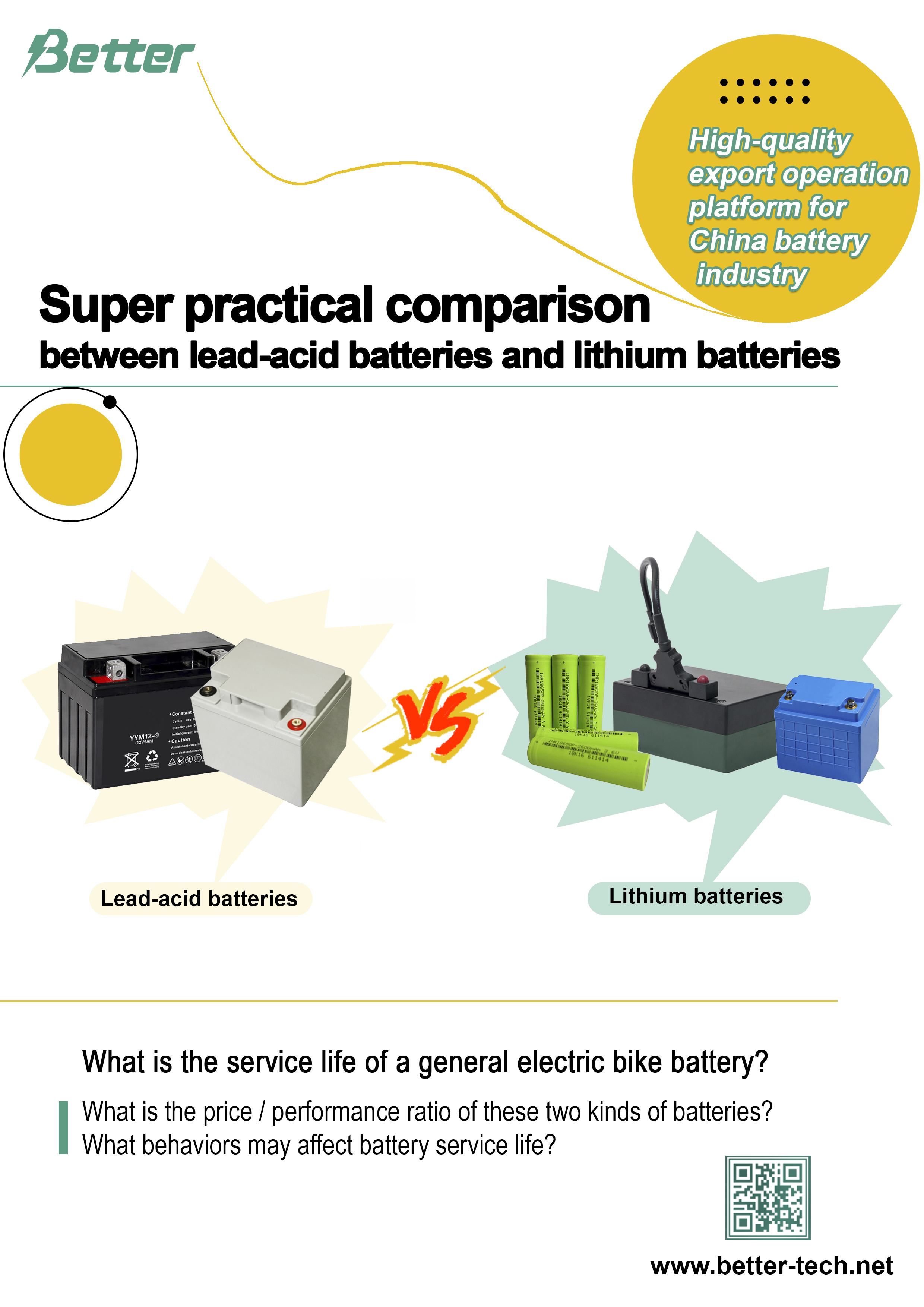
Super practical comparison between lead-acid batteries and lithium batteries
2022-01-06 14:431. Nowadays, many people prefer to buy electric bikes with lithium batteries. There are many types of lithium batteries. What is the difference?
Nowadays, the more widely used lithium batteries on the market are mainly divided into three categories: ternary lithium ion batteries, lithium manganate batteries, and lithium iron phosphate batteries. Among them, ternary lithium batteries and lithium iron phosphate batteries are more widely used. From a safety point of view, the safety of lithium iron phosphate batteries and lithium manganese oxide batteries is higher than that of ternary lithium batteries.
Ternary lithium ion batteries generally use lithium nickel cobalt manganese or nickel cobalt aluminate lithium ion batteries as cathode materials. Different from other lithium-ion batteries, the capacity of ternary lithium-ion batteries is higher than other lithium-ion batteries, and the cycle performance of ternary lithium-ion batteries is better than that of ordinary lithium cobalt oxide lithium-ion batteries. The nominal voltage of the ternary lithium-ion battery is 3.7V, and the working voltage is 2.75V~4.2V. But the thermal stability of ternary lithium is poor, so the safety is not as good as lithium iron phosphate and lithium manganate.

Lithium manganate battery refers to a battery that uses lithium manganate material for the positive electrode. The nominal voltage of lithium manganate battery is 2.5~4.2V. Lithium manganate battery is widely used because of its low cost and good safety. Lithium manganate batteries have the advantages of low cost, strong stability, and strong low-temperature performance, but they also have the disadvantages of low energy density, poor high-temperature performance, and faster attenuation.
Lithium iron phosphate battery refers to a lithium ion battery that uses lithium iron phosphate as the positive electrode material. The lithium iron phosphate power battery has a cycle life of more than 2000 times, and it can be used for 2000 times with standard charging (5 hours rate). The theoretical service life will reach 7 to 8 years, and it is currently the preferred battery cell type with both safety and cost performance.
2. What is the service life of a general electric bike battery?
The service life of lead-acid batteries is only 1~2 years, and the service life is greatly related to the user’s daily maintenance. As mentioned earlier, the service life of different types of lithium batteries is different. At present, most of the lithium batteries on the market could charge and discharge more than 500 cycles, with service life of more than 3 years.

3. What is the price/performance ratio of the two batteries?
Many people like to buy lithium battery electric bikes because of its size. Lead-acid batteries are larger in size and heavier than lithium batteries. When moving, lithium battery electric bikes are definitely better.
The battery with the same 48V20Ah capacity, when the temperature is 25℃ and both are fully charged, the driving mileage of electric bikes loaded with lead-acid batteries will be less than that of electric bikes loaded with lithium batteries. The specific driving mileage depends on the speed of driving, the weight of the driver and road gradient, etc. In terms of battery capacity, lead-acid batteries are slightly inferior to lithium batteries.
The general driving mileage of the lead-acid battery 48V20Ah battery pack is 35km~40km. In the new state of the battery, it can basically meet the needs of users within 30km commuting distance every day. Users who commute to get off work more than 40km every day please choose lithium batteries group higher than 48V30Ah.
In terms of price, the purchase price of lithium batteries is higher than that of lead-acid batteries.
However, in terms of the average annual cost of use, lithium iron phosphate batteries will be lower than lead-acid batteries, and the use experience will be better.
4. What behaviors may affect battery service life?
The first thing to protect lead-acid batteries is to protect the charger.
Generally, the charger should not be placed in the trunk or basket of the electric bike. Under special circumstances, it must be moved, and the charger must be packed with foam to prevent vibration.
After many chargers undergo vibration, their internal components will be unsoldered and the resistance of the potentiometer will drift which may make the entire voltage parameter to drift and result in an abnormal charging state. Moreover, keep the charger ventilated when charging, otherwise it will not only affect the service life of the charger, but also may cause thermal drift which will affect the charging state. This will damage the battery. Therefore, it is very important to protect the charger.
Second, charge it every day. Even if you don't have long requirements for the ability to continue, you can use it for 2 to 3 days with single charge, but it is still recommended to charge it every day, so that the battery is in light cycle state, and the battery life will be prolonged.
Some early mobile phone users think that it is best to charge the battery after it is basically used up. This is not correct. The memory of lead-acid batteries is not that strong. Frequent discharge of electricity has a greater impact on the life of the battery. Most chargers may be 97% to 99% charged after the indicator turns to indicate full charge. Although the influence of only 1% ~ 3% undercharge on the running capacity can be almost ignored, it will also form undercharge accumulation, so after the battery is fully charged, it is better to continue the float charging as much as possible, which is also beneficial to prevent lead-acid battery sulfuration.
Deep discharge regularly. A regular deep discharge of the battery is also conducive to "activating" the battery, which can slightly increase the battery's capacity. The general method is to fully discharge the battery periodically. The method of full discharge is to ride the bike under normal load conditions on a flat road to the first undervoltage protection. Note that special emphasis is placed on the first undervoltage protection. After the battery is under voltage protection for the first time, after a period of time, the voltage of the battery will rise and return to a non-undervoltage state. At this time, if the battery is used again, the battery will be seriously damaged. After the complete discharge, the battery is fully charged. You will feel that the battery capacity has improved.
Users should pay attention to the charging environment. The best ambient temperature for charging is 25°C. At present, most chargers do not have an automatic control system that adapts to the ambient temperature, so most chargers are designed according to the ambient temperature of 25°C, so charging at 25°C is better. Otherwise, the problems of undercharging in winter and overcharging in summer are prone to occur. However, it is rare that the ambient temperature is really 25°C, so there will inevitably be the problem of overcharging in summer and undercharging in winter. When charging, it is best to arrange the battery and charger in a ventilated and temperature-regulated environment.
It is especially reminded that when the battery is in high temperature in summer, pay attention to the safety of the battery. Try to put the battery in a ventilated environment, do not charge in a high temperature environment, and avoid water in the battery as much as possible.
